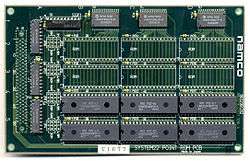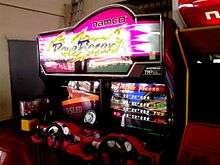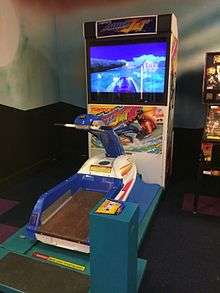Namco System 22

The Namco System 22 is the successor to the Namco System 21 arcade system board. It debuted in 1992 with Sim Drive in Japan,[1] followed by a worldwide debut in 1993 with Ridge Racer.
The System 22 was designed by Namco with assistance from graphics & simulation company Evans & Sutherland. Graphical features include texture mapping, Gouraud shading, transparency effects, and depth cueing, thanks to the Evans & Sutherland 'TR3' chip/chipset, which stands for: Texture Mapping, Real-Time, Real-Visual, Rendering System. The main CPU provides a scene description to the TR3 graphics processing unit and a bank of DSP chips which perform 3D calculations.
A variant of the system, called the Super System 22, was released in 1995. The hardware was largely similar to the System 22, but with a slightly higher polygon rate and more special effects possible.
Both Super System 22 and System 22 can render significantly better graphics, more polygons with sharper texture-mapping, running in higher resolution and at a higher framerate compared to the graphics capabilities of the original Sony PlayStation, the Sega Saturn and the Nintendo 64 video game systems, but much less than what the Sega Dreamcast can produce.
According to Namco America the twin seat Ridge Racer arcade unit sold to distribution for $11,995.00 in 1993.
System 22 Specifications
- Main CPU: Motorola 68020 32-bit @ 24.576 MHz
- DSP: 2x Texas Instruments TMS32025 @ 49.152 MHz (exact number of DSPs may vary)
- GPU: Evans & Sutherland TR3 (Texture Mapping, Real-Time, Real-Visual, Rendering System)
- Features: Texture mapping, Gouraud shading, transparency effects, depth cueing, 16.7 million colors, 240,000 polygons/second[2]
- Sound CPU: Mitsubishi M37702 (System 22 Games) or M37710 (Super System 22 Games) @ 16.384 MHz
- Sound Chip: Namco C352
- + Namco Custom Chips
List of System 22 / Super System 22 Games



- Sim Drive (1992, limited release)[1][3]
- Ridge Racer (1993)
- Ace Driver (1994)
- Alpine Racer (1994)
- Cyber Commando (1994)
- Ridge Racer 2 (1994)
- Ace Driver: Victory Lap (1995)
- Air Combat 22 (1995)
- Cyber Cycles (1995)
- Dirt Dash (1995)
- Rave Racer (1995)
- Time Crisis (1995)
- Tokyo Wars (1995)
- Alpine Racer 2 (1996)
- Alpine Surfer (1996)
- Aqua Jet (1996)
- Armadillo Racing (1996)
- Prop Cycle (1996)